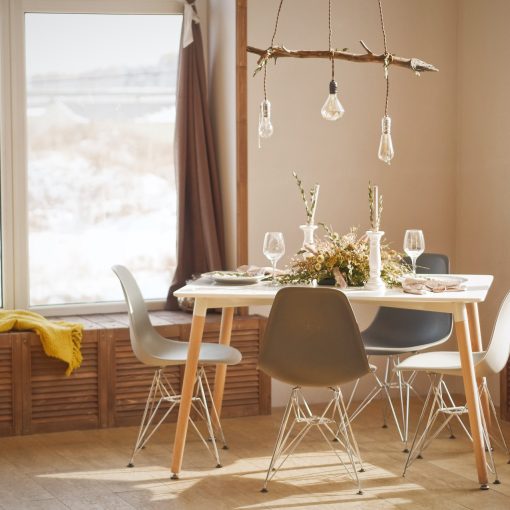Moving into a new home comes with many tasks both before and after the relocation, and planning your furniture layout is one example. While it is already challenging to find and purchase pieces that will fit in your first residence, the task becomes even more daunting when you are moving existing furniture from your old home to your new one.
Since there is very little chance that your new home has the exact same dimensions as the old one, you will need to find a way to adjust. You must consider the positions of the doors, windows, and pathways when arranging furniture pieces to achieve optimum comfort and functionality.
As such, you must prepare the layout of your home’s interior before you move in. Doing so will also allow you to take advantage of the relocation assistance services you hire by directing the movers to put each furniture piece in its assigned room.
To help get you started, below are some tips you can try when arranging furniture before you move in:
1. Measure the Space Twice
The first thing you need to do before buying new furniture is to measure the available space. List down the dimensions of each room and plot these into a floor plan to give you a bird’s-eye view of the layout of the house. This will also help you find places for your existing belongings and determine whether you need to buy new furnishings to adjust to the available area and its complexities.
When doing this, the room must be empty to ensure that you get the exact measurement of the area, with every nook and cranny included. Ideally, measurements should be taken twice to ensure that you got them all right.
2. Clear the Way
When plotting the arrangement of furniture, you should always keep the traffic flow in every room in mind. The rule of thumb is to leave an open space that is at least 0.61 meters or 2 feet wide to accommodate foot traffic.
It is also wise to determine a focal point, such as a large window, fireplace, or a large painting, for every room which will serve as the center of the interior layout.
3. Determine the Purpose of Each Room
Whether you’re arranging new furniture or old ones from your previous home, it is imperative that you determine the purpose of each room before planning their layout. This means that you must first define how the room would be used so you can optimize the entire space. Doing so will ensure that the room doesn’t feel cluttered and will still function as intended.
For example, if one room will double as an entertainment space and temporary overnight lodging for guests, adding a sofa bed instead of the traditional mattress and bed frame combination is your best option. This will achieve both purposes while maintaining the aesthetics and creating sufficient space.
4. Arrange the Basics First
Prioritizing is the key to fitting out the interior of a room for furniture layout. This will ensure that you have the most important pieces of furniture necessary for a specific room. It will also give you time to reconsider the ones you have, especially if they tend to dominate the room and leave no space for other furniture.
Some of the basic pieces of furniture you should have are beds for the bedrooms and guest rooms, a dining table and chairs for the dining area, and a sofa or couch for the living room. If your new home doesn’t have built-in cabinets, you may also need to plan for storage pieces like dressers and drawers.
Once you’re able to put these in their places, you can now arrange your end tables, lamp shades, and décors like mirrors and hanging pictures to liven up the area.
5. Balance the Layout Well
Creating a furniture layout is more than just assigning space for every piece – it should be well-balanced, too. Here are some ways you can do just that:
- Find a place for heavy furniture and keep the room balanced by adding another big piece or a group of smaller items opposite the heavy ones.
- Never put all pieces of furniture against the wall. Utilize the middle space to give depth to the room.
- Balance the layout of your furniture by arranging them according to their height to create a multi-leveled design. For example, if you have a piece that is shorter than others, simply hang a large painting or picture frame on top of it to make the room seem taller.
6. Make Textures and Colors Work
Adding a combination of textures and colors to your new house is also a great way to make the place feel more alive and less cluttered.
Choose pieces of furniture with eye-catching hues to add personality to a room, but remember not to overuse a single color. Spread patterns throughout the space by throwing in couch pillows, picture frames, and curtains which will do great in enhancing neutral-hued walls.
Textures can also help add depth to a room. Choose materials like wood, marble, or metal to create a well-grounded room and match these with pieces made from wicker and fabric for a more relaxed, breezy vibe.
7. Create Space for Every Piece
Arranging furniture pieces in your new home requires your attention the same way the relocation itself does – both activities entail thorough planning and preparation. Make sure to do your research before accomplishing the task, and ask for help when necessary.
AUTHOR BIO
Robert Wise, Sales Administration Manager at Nuss Removals, has been a respected figure in the removals industry for over 20 years. His attention to detail and the ability to truly understand the needs of the customer have ensured the successful relocation of thousands of satisfied individuals and families. For moving and storage across Australia and around the world, Robert’s wealth of experience ensures his customers are in safe hands.
All opinions and facts are that of a third-party writer, not an official Feenta.com author. It’s an article written by a guest author. If you’d like to submit an article, go to our Write for Us page.





